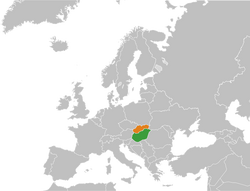
Hungary-Slovakia
The Second Hungary-Slovak War, also known as the Second Magyar-Slovak War was an armed conflict between the Slovak Republic and the Republic of Hungary which lasted from the 28th June 2010 to 26th August 2010 and resulted in a EU brokered ceasefire in which some parts of southern Slovakia were ceded to Hungary. As well as being the first ever war between members of both NATO and the European Union, it is also one of the only wars to be fought between two democratic nations and resulted in both nations being temporarily suspended from NATO.
| Second Hungary-Slovakia War | |||||
|---|---|---|---|---|---|
|
|||||
BACKGROUND[]
The background to the war can be found in the 2010 Parliamentary elections in which the conservative party Fidesz under Viktor Orbán won the election with 52.73% of the votes and 263 of the seats (out of a total number of 386). A new citizenship law gained a majority in the National Assembly on 14th May which put huge strain on the two countries relations as the law allows ethnic Hungarians living in other countries (e.g. Slovakia) to apply for duel citizenship. In a tit-for-tat exchange, Slovakia retaliated later the same day with its own legislation threatening that anyone who applies for citizenship of another country will lose their Slovak citizenship. This was to come into effect sometime in July. Naturally, this only served to worsen the relations and increase tensions.
Relations between Hungary and Slovakia had been deteriorating for years with Slovak National Party leader Ján Slota, a far right member of the government and staunch anti-Hungarian, even threatening to "flatten Budapest with tanks". At 12:34 PM on the 28th June, angry ethnic Hungarians protest in the south of the country against the Slovak legislation which will remove Slovak citizenship should they apply for Hungarian citizenship. Far-right supporters of the SNS (Slovak National Party)confront them and a fight starts. The fight escalates when several more SNS supporters arrive, brandishing handguns purchased off the black market and shoot at the Hungarians, who are unarmed. The Hungarians immediately flee, hoping to find safety over the border. The SNS supporters give chase, even crossing the border into Hungary, where Hungarian police open fire on the armed men, killing three SNS supporters. One police officer is wounded in the fire fight and dies of his wounds on the way to hospital. News of this quickly reaches the media of both countries with feelings already running high, it seems certain that the first war between Hungary and Slovakia since the Magyar-Slovak War of 1939, is about to start.
Hungarian troops begin to arrive near the border by 4:00 PM in an effort to prevent further cross border incidents, all of this being seen by the worlds media fueling fears of conflict. Seeing this, the Slovak government orders a partial mobilisation of its reserves and sends several thousand troops towards the border with Hungary. Riots begin in the Hungarian speaking south of Slovakia, where 60% of the population is ethnic Hungarian. Riots rage across the south as people hear of the shooting. The rioters are demanding the Slovak government step down, and new elections be held, which the government refuses to do. In response to the riots, the area is placed under martial law, and six rioters are shot dead by Slovak Army units, and dozen more are wounded. At least two Slovak soldiers are killed in the fighting and several more are wounded. Over a thousand people protest in front of the Slovakian embassy in Budapest, burning Slovak flags and attempting to storm the building, although police manage to hold them back. Within an hour of the protests, all embassy personnel are evacuated from the building by helicopter and are flown back to Slovakia.
Rioting continues in south Slovakia and Hungarian media reports that Slovak police have shot at least four more people dead, although the police deny this claim. As the riots continue, there also more incidents of SNS supporters attacking ethnic Hungarians and trying to drive them over the border. Hungarian soldiers who have recently arrived on the border open fire on the SNS and kill at least three of them and wound another in order to protect the ethnic Hungarians being attacked. The SNS, however, were still on the Slovakian side of the border. Slovak soldiers arrive at the scene less than an hour later and both sides shout insults at each other, although refrain from firing, that is, until a teenage SNS supporter throws a Molotov cocktail over the border at the Hungarians. Although the Molotov misses the soldiers, they still open fire on him and kill him, resulting Slovak troops nearby shooting at the Hungarians. The brief firefight results in the death of four Hungarian soldiers and three Slovak soldiers(as well as two armed SNS supporters near them).
The Second Hungary-Slovak War begins[]
At 7:34 PM, 28th June, under the pretext of protecting its citizens, the Hungarian Army began an assault along much of its border with Slovakia. At the same time, the Hungarian Air Force bombed two Slovak air bases and destroyed several aircraft, and forced Bratislava airport to close down and divert civilian aircraft to Prague in the Czech Republic. At least eight civilians are killed in the first 20 minutes of the war during a bombing raid in the Slovak capital, Bratislava.
Hungarian infantry stormed across the border, expecting only limited resistance, not realising that Slovak forces had been preparing defensive positions all day. The resistance the Hungarians met was anything but limited, and dozens of Hungarian troops were killed in the first hour due to a combination of Slovak infantry, tanks and helicopter defences. At 9:00 PM, the Slovak Air Force bombed a Hungarian Army convoy which had just crossed the border, killing 34 Hungarian soldiers, and blocking the road to military traffic for the rest of the night, giving Slovak troops at least a little more time to prepare.
Within 15 minutes of the Hungarian attack, all major news outlets on the planet were reporting on the developing conflict, although no news crews had yet arrived at the scene, but some amateur videos had already made their way onto Youtube and other websites.
By 10:30 PM, the Hungarian Army had captured several small border villages, and were mostly welcomed as liberators. An hour later, Hungarian tanks were rapidly advancing up the E71 road towards the city of Kosice, however, Slovakian troops were waiting to ambush them in the town of Haniksa, not far from Kosice. Slovakian tanks and anti tank rockets destroyed 12 Hungarian armoured vehicles in only ten minutes, and more Slovakian troops arrived and tried to encircle the Hungarians, and although the Hungarians took several casualties, reinforcements arrived by helicopter as did air support from the air force, mauling the Slovak troops attempting to encircle them. This did not deter the defenders of Haniksa who continued to fight on to allow defences in Kosice time to be prepared. The Battle of Haniksa raged until the early hours of the morning when the Slovakian forces finally had to withdraw under intense air and artillery bombardment. By 5:00 AM, the routed Slovakian troops had reached Kosice and helped the soldiers already there continue to prepare defences.
At the same time, Hungarian troops further west were still having no luck breaking the border defences set up by the Slovaks. It was clear that this attack was aimed to capture the capital Bratislava, which lay not too far north of the border. Already an exodus was occurring as thousands fled north from the city, which had come under constant air attack by the Hungarian Air Force. In response to the air raids on their capital, the Slovak Air Force began its first bombing attacks on Hungarian cities at 7:00 AM, hitting an army base in Budapest and an air base on the outskirts of Gyor. Further attacks damaged Budapest Airport and an aircraft bombed the Presidential Palace in Budapest, although the President was unharmed as he had been evacuated hours earlier.
At 9:00 AM, the Hungarian Army reached the city of Kosice, although it did not immediately start its offensive as they wanted to consolidate their forces and allow civilians time to evacuate from the city to avoid large scale casualties, this undoubtedly saved many lives.
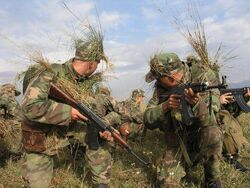
Slovak troops prepare an ambush
At 12:03 PM, the Battle of Kosice officially began with an air and artillery attack of Slovak positions in and around the city. Although most civilians had been evacuated, many chose to remain and almost 36 civilians died in the first hour of the battle. Slovakian troops fought bravely. However, the defences on the outskirts of the city were overcome in only nine hours. However, the city itself, particularly the buildings, had been fortified and garrisoned with infantry, and many anti-tank weapons.
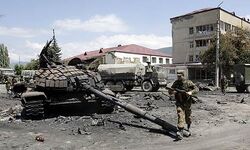
Destroyed Hungarian tank
By this point, ten Hungarian jets had been shot down over Slovakia, as had one troop transport plane and eight Slovak jets had been brought down over Hungary, and another two shot down in a dogfight with Hungarians above Kosice.
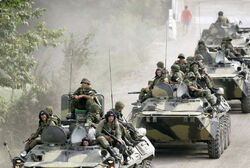
Hungarians Advance
Reporters and journalists from all over the world, including CNN, FOX, BBC, SKY, al Jazeera, Russia Today and dozens others were reporting on the war, and many were reporting live from Kosice despite the danger. Live footage was being broadcast around the world of the two countries military forces battling each other, and many broadcasters had rescheduled some of their programming to make room for longer news updates.
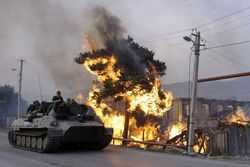
Kosice suffers heavy damage
Slovakia declared a nationwide state of emergency at 9:35 AM, June 23rd. Hungary declares a state of emergency for its northern provinces two hours later.
With 24 hours of the outbreak of hostilities, Hungary had suffered 175 military fatalities, and Slovakia 204.
At 12:45 PM on 23rd June, the Republic of Slovakia officially declared itself to be in a State of War with the Republic of Hungary. Both the United Nations and European Union called for a ceasefire, followed shortly after by NATO, but the calls went unheeded.
The Hungarian attacks in the West were still unable to break the Slovak defences. However, in the East, Hungarian troops were advancing into the city. The Slovak Army was putting up a fierce resistance and forced the Hungarians to pay for every inch of ground they gained. Kosice's Armed Police joined in with the army, as well as armed civilian volunteers who had decided to stay and fight for their homes. Street to street, house to house and room to room fighting raged throughout Kosice as warplanes and helicopter gunships circled overhead, picking off infantry on the ground.
On the 24th of June, with fighting showing no sign of ending, the Czech Republic officially voiced its support for its neighbour, although it refused to contribute militarily, instead choosing to send humanitarian aid across the border and expel the Hungarian ambassador in Prague for "acts of aggression against the Slovak Republic"
Throughout the 24th, reinforcements for both sides began to arrive in Kosice and the fighting seemed to be intensifying, forcing many journalists to leave the area. One war correspondent for the BBC was killed during a live broadcast by shrapnel when a Slovak artillery shell landed near him. Although his death was entirely unintentional on the Slovak part, they still blamed it on Hungary to avoid bad publicity.
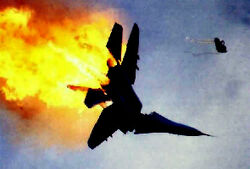
Slovak jet shot down by SAM
Health officials in Slovakia claim the country's civilian death toll has reached 56, with at least 700 wounded. Later the same day, 12 Hungarian civilians are killed when a Slovak Air Force jet is shot down over Budapest and crashes into an apartment block. The pilot, who ejected before being shot down, parachutes down and lands near the scene of the incident. He is beaten to death by an angry mob, many of whom had lived in, or knew people who lived in the apartment block. Shortly after this incident, attacks on ethnic Slovaks living in Hungary increase significantly, with at least 430 attacks reported, and 13 Slovaks murdered, and double that hospitalised. Similar incidents are also reported in Slovakia, where attacks on ethnic Slovaks have also hugely increased since the war started.
